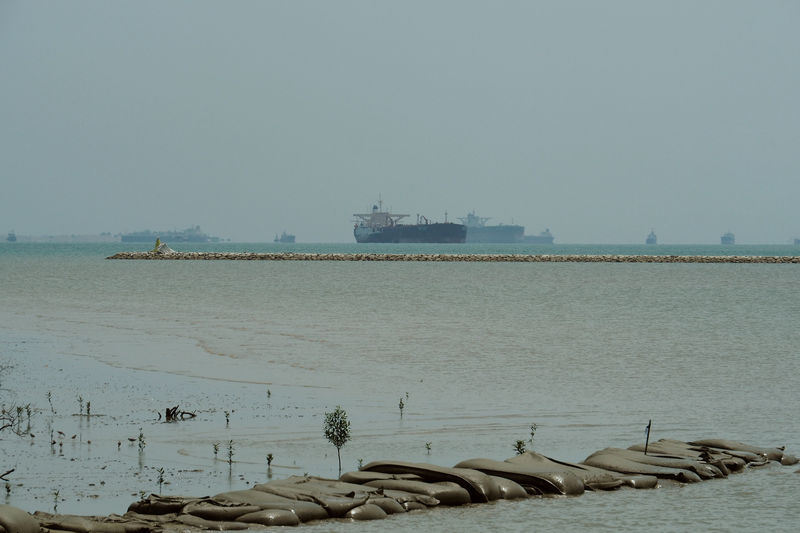* China plans to ship more U.S. oil in Aug-Sept
* OPEC+ compliance with output cuts in July 97% -sources
* OPEC+ ministerial panel to meet on Aug. 19
(Updates with settlement prices, adds commentary)
By Laura Sanicola
NEW YORK, Aug 17 (Reuters) - Oil prices settled higher on
Monday, as OPEC+ producers almost fully complied in July with
their global production cut accord, and after U.S. officials
said China is in compliance with the first phase of the two
nations' trade deal.
Brent crude LCOc1 settled up 57 cents, or 1.3%, to $45.87
a barrel, and U.S. West Texas Intermediate crude CLc1 was up
88 cents, or 2.1 %, to $42.41 a barrel.
Compliance with OPEC+ oil output cuts is seen at around 97%
in July, two OPEC+ sources told Reuters. The oil-producing
nations have been cutting output by record levels to curb supply
and reduce worldwide inventories.
China is living up to its end of the trade deal the two
parties signed in January, U.S. President Donald Trump said on
Monday, even though the nation has fallen short so far of
promised purchases of U.S. products.
Chinese state-owned oil firms have tentatively booked
tankers to transport at least 20 million barrels of U.S. crude
for August and September. "There's indications of demand picking up in China...we are
not in a bull market by a long run but the demand story in China
really seems to be what the market is focusing on," said John
Kilduff, partner at Again Capital in New York.
Investors are waiting on Wednesday's ministerial OPEC+
committee, known as the JMMC, that will review compliance with
the global oil supply reduction pact, although no change in the
agreement is expected.
In August, the Organization of the Petroleum Exporting
Countries and allies known as OPEC+ eased its agreed cuts to 7.7
million barrels per day (bpd) from 9.7 million bpd previously.
Later-dated Brent futures contracts suggest traders see
inventories remaining high in coming months due to weakened
demand.
Last week the U.S. Energy Information Administration
adjusted global oil demand downward, suggesting a smaller than
previously expected reduction in global inventories.
<^^^^^^^^^^^^^^^^^^^^^^^^^^^^^^^^^^^^^^^^^^^^^^^^^^^^^^^^^^^
Demand/supply balance https://tmsnrt.rs/3aptIIv
^^^^^^^^^^^^^^^^^^^^^^^^^^^^^^^^^^^^^^^^^^^^^^^^^^^^^^^^^^^>
- English (USA)
- English (UK)
- English (India)
- English (Canada)
- English (Australia)
- English (South Africa)
- English (Nigeria)
- Deutsch
- Español (España)
- Español (México)
- Français
- Italiano
- Nederlands
- Português (Portugal)
- Polski
- Português (Brasil)
- Русский
- Türkçe
- العربية
- Ελληνικά
- Svenska
- Suomi
- עברית
- 日本語
- 한국어
- 简体中文
- 繁體中文
- Bahasa Indonesia
- Bahasa Melayu
- ไทย
- Tiếng Việt
- हिंदी
UPDATE 9-Oil rises on China plan to boost U.S. imports, OPEC+ compliance
Published 08/17/2020, 12:33 PM
Updated 08/18/2020, 03:40 AM
UPDATE 9-Oil rises on China plan to boost U.S. imports, OPEC+ compliance

Latest comments
Install Our App
Risk Disclosure: Trading in financial instruments and/or cryptocurrencies involves high risks including the risk of losing some, or all, of your investment amount, and may not be suitable for all investors. Prices of cryptocurrencies are extremely volatile and may be affected by external factors such as financial, regulatory or political events. Trading on margin increases the financial risks.
Before deciding to trade in financial instrument or cryptocurrencies you should be fully informed of the risks and costs associated with trading the financial markets, carefully consider your investment objectives, level of experience, and risk appetite, and seek professional advice where needed.
Fusion Media would like to remind you that the data contained in this website is not necessarily real-time nor accurate. The data and prices on the website are not necessarily provided by any market or exchange, but may be provided by market makers, and so prices may not be accurate and may differ from the actual price at any given market, meaning prices are indicative and not appropriate for trading purposes. Fusion Media and any provider of the data contained in this website will not accept liability for any loss or damage as a result of your trading, or your reliance on the information contained within this website.
It is prohibited to use, store, reproduce, display, modify, transmit or distribute the data contained in this website without the explicit prior written permission of Fusion Media and/or the data provider. All intellectual property rights are reserved by the providers and/or the exchange providing the data contained in this website.
Fusion Media may be compensated by the advertisers that appear on the website, based on your interaction with the advertisements or advertisers.
Before deciding to trade in financial instrument or cryptocurrencies you should be fully informed of the risks and costs associated with trading the financial markets, carefully consider your investment objectives, level of experience, and risk appetite, and seek professional advice where needed.
Fusion Media would like to remind you that the data contained in this website is not necessarily real-time nor accurate. The data and prices on the website are not necessarily provided by any market or exchange, but may be provided by market makers, and so prices may not be accurate and may differ from the actual price at any given market, meaning prices are indicative and not appropriate for trading purposes. Fusion Media and any provider of the data contained in this website will not accept liability for any loss or damage as a result of your trading, or your reliance on the information contained within this website.
It is prohibited to use, store, reproduce, display, modify, transmit or distribute the data contained in this website without the explicit prior written permission of Fusion Media and/or the data provider. All intellectual property rights are reserved by the providers and/or the exchange providing the data contained in this website.
Fusion Media may be compensated by the advertisers that appear on the website, based on your interaction with the advertisements or advertisers.
© 2007-2024 - Fusion Media Limited. All Rights Reserved.